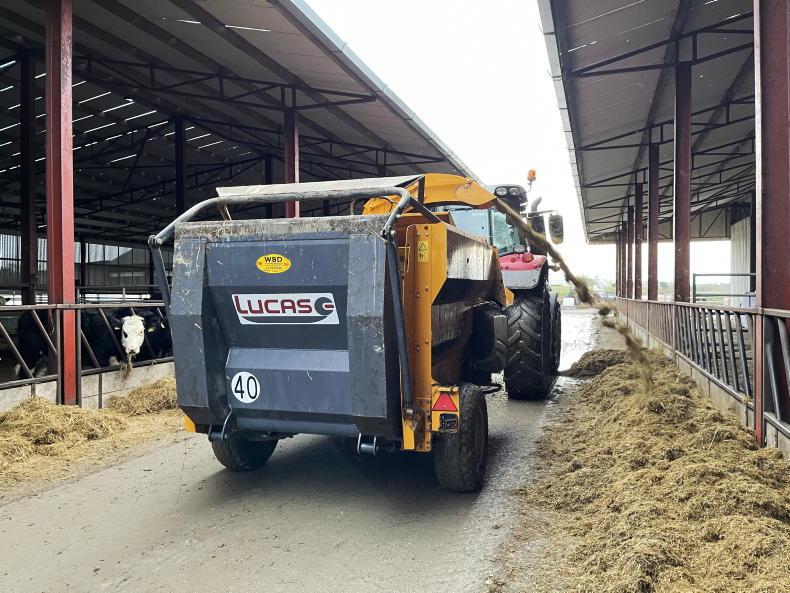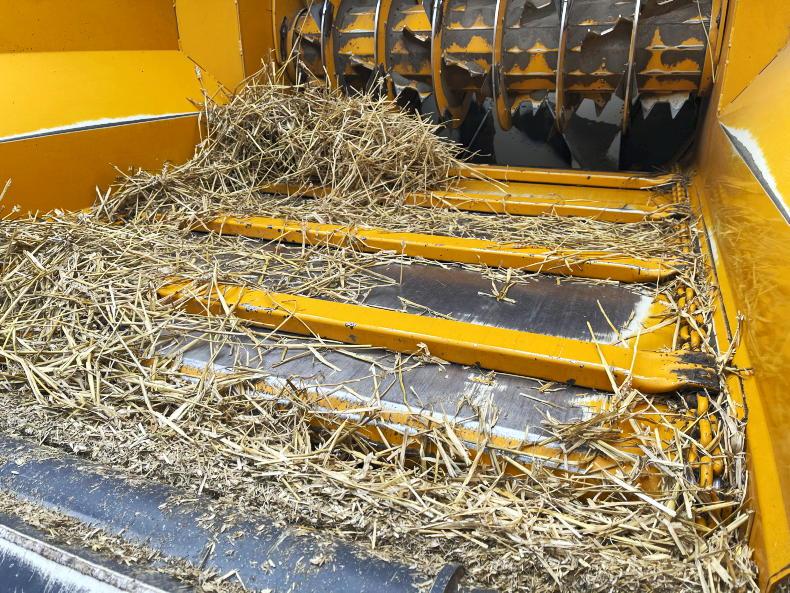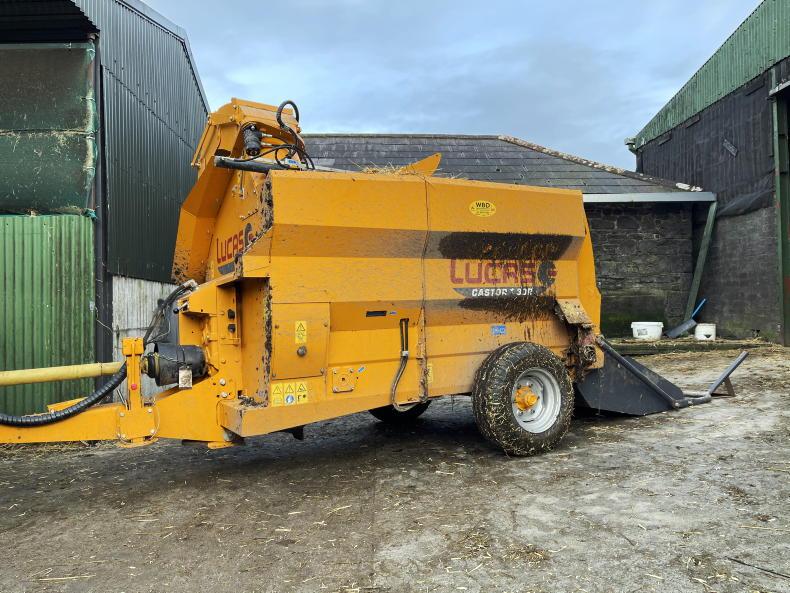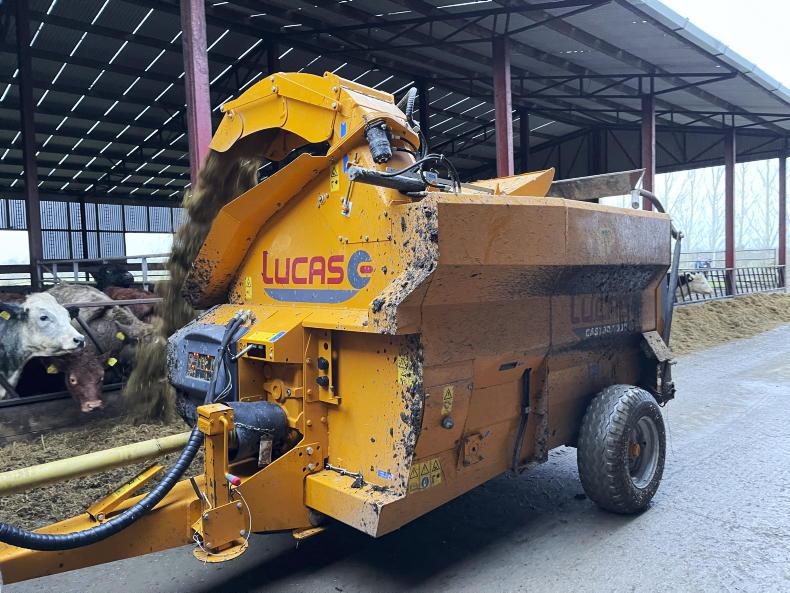Located between Stamullen and Naul on the Meath side of the Dublin border, Barry Ryan runs a 150-cow dairy enterprise and finishes in the region of 250 beef cattle annually.
Barry operates a slightly different system to the norm in that he opts for a multipurpose cow that has the ability to milk well and breed a calf with good beef traits.
With this in mind, Barry’s herd is mainly made up of British Friesian and Montbeliarde cows, although he noted that in recent years he has introduced a number of Rotbunt cows to the herd which have done well in terms of milk yield and which produce a quality calf, what he himself describes as an ideal animal for his particular system.
Bedding
What makes Barry’s setup unique is that there are very few slatted sheds or cubicles on the farm. Instead, almost all cattle, including the dairy herd, are housed in large open straw-bedded sheds. Being located in a prime tillage area leaves straw readily available for the winter period, he said.
“It’s the system we have operated for years. We tend to bed daily, little and often, to maintain a clean dry surface for the dairy cows. Over the years we’ve found wheaten straw to work best in terms of soakage. When sheds need to be cleared, local tillage farmers come and take away the dung for tillage ground, so it works well,” he said.

Silage is well presented infront of the fed barrier.
“During the winter, there are days that as many as 20 bales could be needed for bedding. Up until the point of deciding to go down the route of buying a straw blower, we were rolling out and shaking bales out manually,” Barry said.
Straw blower
“During the summer of 2019, it so happened that we made a lot of baled silage, something we don’t usually do. I had heard of a few guys feeding silage bales with straw blowers which helped chop and reduce the labour involved around feeding.
“So we decided to look into buying a straw blower. A few neighbours had them too and found them a great tool for bedding and helping reduce straw usage.
“My nephew Ciaran works on the farm. He mainly looks after the feeding and bedding. So we looked around and had demos of a few different machines from local dealers.
“We liked the Lucas G machine. It seemed well built and simple to use. It wasn’t badly priced compared with the other options on the market either,” Barry explained.
In the end, they opted for the Lucas G Castor 30R model. The men wanted a compact machine suitable for narrow feed passages yet capable of carrying two round bales or one large square bale. A machine well built with a good blow to handle silage was a must too.

The hydraulically driven floor has one of nine pre-set speeds to select from.
Barry took delivery of his Castor 30R in November 2019. Just over one year on, it spends little idle time during the winter, especially when all livestock are housed. Ciaran noted how there are often days when the bulk of his work is just feeding and bedding with the straw blower.
“We use it to feed cattle in a rented shed 2km away. It does a lovely job of feeding out, even the pit silage. It leaves feed nice and fluffy. The trick is to run the floor nice and slow.”
The machine
The Castor 30R has a 3m3 capacity, large enough to carry two round bales (4ft x 4ft) or one large square bale (8ft x 4ft x 4ft). It comes equipped with just one rotor/shredder, although larger models are available within the range with two and three shredders.
The same 282mm-diameter rotor is used within all Castor R models, each equipped with 48 knives and 28 paddles. Its knives are similar to the knife sections on a combine header, in that they are serrated. Given their shape, opposite pairs can be swapped for an extended service life.
Ciaran noted how chop length isn’t a major issue for bedding. He has only recently swapped each of the 48 knives around.
The hydraulic adjustable comb regulates the flow of material. Ciaran noted how this is handy when feeding round bale silage. The flow of silage into the rotor can be slowed to allow more processing time and reduce the possibility of a blockage by pulling in too much.
In straw, Ciaran tends to have the comb opened more so that it is more easily pulled in by the rotor. Once straw or silage has passed through the rotor it is blown up the chute by what Lucas G calls the “turbine”. This 1.6m-diameter turbine is equipped with six blowing paddles and claims a throwing distance of up to 15m with the optional rotating chute.
The Castor 30R is equipped as standard with a two-speed gearbox to handle both straw and wetter forages such as silage. The shredder rotor is mechanically driven via chain and sprocket. Having only broken a shear bolt a small number of times, Ciaran feels this is a good job and a cheaper alternative to replacing belts.

The Lucas G Castor 30R straw blower.
Features
Barry’s machine is fitted with the 270° swivel chute option, which himself and Ciaran feel is a must-have, given the layout of some of their sheds.
The hydraulically driven floor chain has nine preset speeds from 0 to 20m/min. The selected floor preset speed is displayed along with other functions on the front of the machine, all of which are easily visible when the operator looks across their right shoulder. The floor can also be reversed at the press of a button in the event of a blockage.
Controls are simple but effective, according to Ciaran. Four buttons take care of the floor, four buttons for the chute, two buttons for the hydraulic comb and two buttons to raise and lower the rear door, which can also be done outside the cab.
Verdict
“We are well impressed with the machine so far. It has done all we’ve asked of it. It is a much more efficient way of bedding in terms of time and the amount of straw used. It is straightforward and easy to operate. All that we’ve had to do maintenance-wise is tension the floor chains, that’s it.
“It’ll blow somewhere in the region of up to 50ft which is enough for all our sheds. We welded on a blade to the frame on the rear door to help slide in under bales during loading, which was a good success.
“Having used the machine for just over a year, our only regret is that we didn’t purchase one sooner, considering as many as 20 straw bales could be put through the machine in a day, excluding silage.
“It has proved great for feeding cattle in the rented shed up the road. We load the straw blower with four or five blocks of pit silage once or twice a day, depending on cattle numbers, and head off to feed. It saves the need for transporting bales, and as well as this, we’ve found it chops turnips and potatoes well once incorporated with silage. It’s a machine we wouldn’t do without now having got used to it.”
Spec
Model: Lucas G Castor 30R.Capacity: 3m3.Number of knives: 48.Min power requirement: 70hp.Overall length (tailgate up): 3.77m.Overall width: 1.98m.Overall height: 2.43m.Unladen weight: 1,970kg.Oil flow rate (min-max): 30-60l/min.Price: €16,500 excluding VAT.
Located between Stamullen and Naul on the Meath side of the Dublin border, Barry Ryan runs a 150-cow dairy enterprise and finishes in the region of 250 beef cattle annually.
Barry operates a slightly different system to the norm in that he opts for a multipurpose cow that has the ability to milk well and breed a calf with good beef traits.
With this in mind, Barry’s herd is mainly made up of British Friesian and Montbeliarde cows, although he noted that in recent years he has introduced a number of Rotbunt cows to the herd which have done well in terms of milk yield and which produce a quality calf, what he himself describes as an ideal animal for his particular system.
Bedding
What makes Barry’s setup unique is that there are very few slatted sheds or cubicles on the farm. Instead, almost all cattle, including the dairy herd, are housed in large open straw-bedded sheds. Being located in a prime tillage area leaves straw readily available for the winter period, he said.
“It’s the system we have operated for years. We tend to bed daily, little and often, to maintain a clean dry surface for the dairy cows. Over the years we’ve found wheaten straw to work best in terms of soakage. When sheds need to be cleared, local tillage farmers come and take away the dung for tillage ground, so it works well,” he said.

Silage is well presented infront of the fed barrier.
“During the winter, there are days that as many as 20 bales could be needed for bedding. Up until the point of deciding to go down the route of buying a straw blower, we were rolling out and shaking bales out manually,” Barry said.
Straw blower
“During the summer of 2019, it so happened that we made a lot of baled silage, something we don’t usually do. I had heard of a few guys feeding silage bales with straw blowers which helped chop and reduce the labour involved around feeding.
“So we decided to look into buying a straw blower. A few neighbours had them too and found them a great tool for bedding and helping reduce straw usage.
“My nephew Ciaran works on the farm. He mainly looks after the feeding and bedding. So we looked around and had demos of a few different machines from local dealers.
“We liked the Lucas G machine. It seemed well built and simple to use. It wasn’t badly priced compared with the other options on the market either,” Barry explained.
In the end, they opted for the Lucas G Castor 30R model. The men wanted a compact machine suitable for narrow feed passages yet capable of carrying two round bales or one large square bale. A machine well built with a good blow to handle silage was a must too.

The hydraulically driven floor has one of nine pre-set speeds to select from.
Barry took delivery of his Castor 30R in November 2019. Just over one year on, it spends little idle time during the winter, especially when all livestock are housed. Ciaran noted how there are often days when the bulk of his work is just feeding and bedding with the straw blower.
“We use it to feed cattle in a rented shed 2km away. It does a lovely job of feeding out, even the pit silage. It leaves feed nice and fluffy. The trick is to run the floor nice and slow.”
The machine
The Castor 30R has a 3m3 capacity, large enough to carry two round bales (4ft x 4ft) or one large square bale (8ft x 4ft x 4ft). It comes equipped with just one rotor/shredder, although larger models are available within the range with two and three shredders.
The same 282mm-diameter rotor is used within all Castor R models, each equipped with 48 knives and 28 paddles. Its knives are similar to the knife sections on a combine header, in that they are serrated. Given their shape, opposite pairs can be swapped for an extended service life.
Ciaran noted how chop length isn’t a major issue for bedding. He has only recently swapped each of the 48 knives around.
The hydraulic adjustable comb regulates the flow of material. Ciaran noted how this is handy when feeding round bale silage. The flow of silage into the rotor can be slowed to allow more processing time and reduce the possibility of a blockage by pulling in too much.
In straw, Ciaran tends to have the comb opened more so that it is more easily pulled in by the rotor. Once straw or silage has passed through the rotor it is blown up the chute by what Lucas G calls the “turbine”. This 1.6m-diameter turbine is equipped with six blowing paddles and claims a throwing distance of up to 15m with the optional rotating chute.
The Castor 30R is equipped as standard with a two-speed gearbox to handle both straw and wetter forages such as silage. The shredder rotor is mechanically driven via chain and sprocket. Having only broken a shear bolt a small number of times, Ciaran feels this is a good job and a cheaper alternative to replacing belts.

The Lucas G Castor 30R straw blower.
Features
Barry’s machine is fitted with the 270° swivel chute option, which himself and Ciaran feel is a must-have, given the layout of some of their sheds.
The hydraulically driven floor chain has nine preset speeds from 0 to 20m/min. The selected floor preset speed is displayed along with other functions on the front of the machine, all of which are easily visible when the operator looks across their right shoulder. The floor can also be reversed at the press of a button in the event of a blockage.
Controls are simple but effective, according to Ciaran. Four buttons take care of the floor, four buttons for the chute, two buttons for the hydraulic comb and two buttons to raise and lower the rear door, which can also be done outside the cab.
Verdict
“We are well impressed with the machine so far. It has done all we’ve asked of it. It is a much more efficient way of bedding in terms of time and the amount of straw used. It is straightforward and easy to operate. All that we’ve had to do maintenance-wise is tension the floor chains, that’s it.
“It’ll blow somewhere in the region of up to 50ft which is enough for all our sheds. We welded on a blade to the frame on the rear door to help slide in under bales during loading, which was a good success.
“Having used the machine for just over a year, our only regret is that we didn’t purchase one sooner, considering as many as 20 straw bales could be put through the machine in a day, excluding silage.
“It has proved great for feeding cattle in the rented shed up the road. We load the straw blower with four or five blocks of pit silage once or twice a day, depending on cattle numbers, and head off to feed. It saves the need for transporting bales, and as well as this, we’ve found it chops turnips and potatoes well once incorporated with silage. It’s a machine we wouldn’t do without now having got used to it.”
Spec
Model: Lucas G Castor 30R.Capacity: 3m3.Number of knives: 48.Min power requirement: 70hp.Overall length (tailgate up): 3.77m.Overall width: 1.98m.Overall height: 2.43m.Unladen weight: 1,970kg.Oil flow rate (min-max): 30-60l/min.Price: €16,500 excluding VAT. 








 This is a subscriber-only article
This is a subscriber-only article











SHARING OPTIONS: